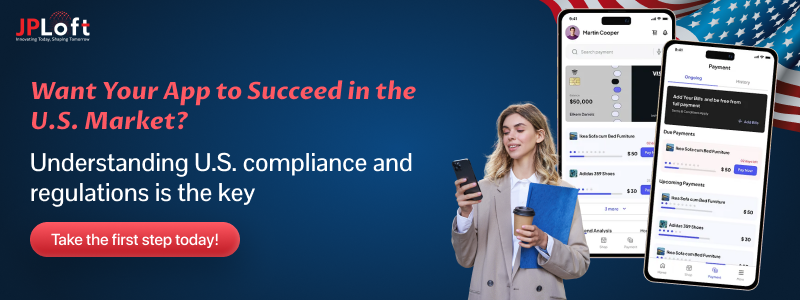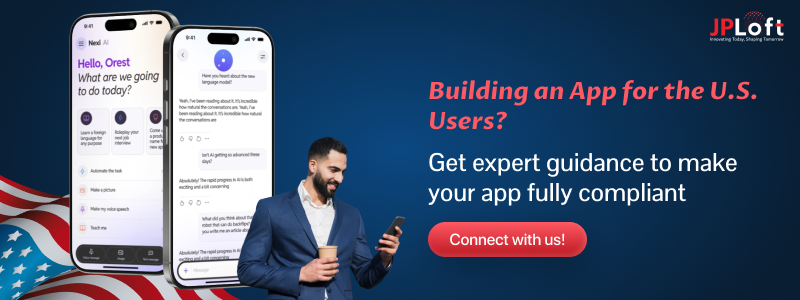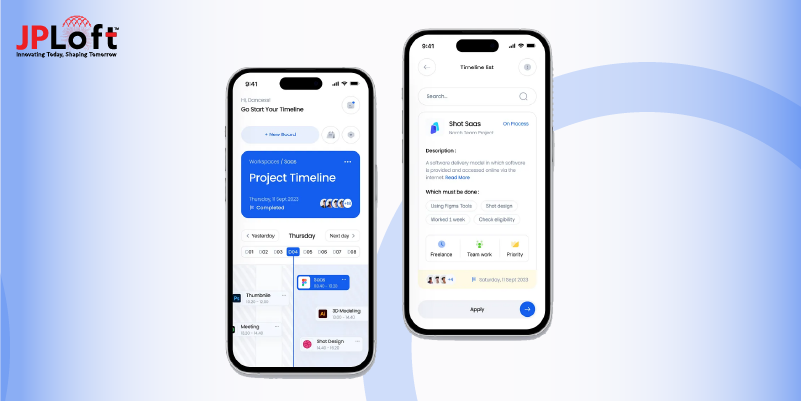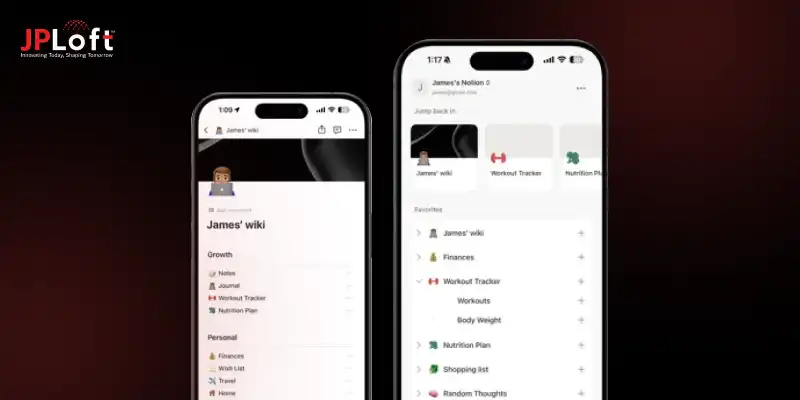Key Takeaways:
Understanding how U.S. compliance and regulations impact app development helps create secure and trustworthy apps ready for the American market.
Regulations like HIPAA, CCPA, and COPPA define how apps collect, store, and use user data, ensuring privacy and transparency.
Following data privacy compliance USA and using encryption, secure APIs, and audits protects sensitive information from breaches.
Transparent data practices and user consent mechanisms increase credibility and long-term user engagement.
Compliance with U.S. laws helps, but GDPR imposes additional, stricter requirements (e.g., lawful bases, DPO in some cases, EU representative, data transfer controls), so alignment isn’t automatic.
As a leading app development company, JPLoft builds secure, regulation-compliant, and scalable apps that meet all U.S. legal standards.
The impact of laws and data protection standards on app creation is stronger than ever. How U.S. compliance and regulations impact app development is a crucial factor every developer must understand before launching in the American market.
With growing awareness of user rights and privacy, aligning with data privacy compliance has become non-negotiable. Strict United States app regulations ensure that apps handle personal data responsibly, making compliance a core part of every development process.
So, in this blog, we’ll uncover how U.S. laws like HIPAA and CCPA influence app development, the key challenges developers face, the best ways to stay compliant, and why mastering compliance is vital for building secure, successful apps in the U.S. market.
Understanding U.S. Compliance and Regulations
Before diving into the U.S. market, every developer must first understand how U.S. app regulations influence the entire app development process, from design to deployment.
These laws are not just legal requirements but frameworks that ensure apps are safe, transparent, and respectful of user privacy.
As digital platforms continue to grow, app development compliance regulations have become more stringent, holding developers accountable for how they collect, store, and manage user data.
Compliance and regulations in app development cover multiple aspects, including data encryption, user consent, breach notification, and secure payment handling.
Whether you’re developing a healthcare app, a financial platform, or a lifestyle product, adhering to mobile app compliance helps you meet user expectations while maintaining full legal protection.
At the same time, software compliance regulations provide developers with clear guidelines on how to safeguard data integrity and prevent unauthorized access.
Following these rules not only keeps your app aligned with U.S. laws but also strengthens your brand’s reputation in an increasingly privacy-aware market.
Understanding these compliance layers early in the development cycle helps avoid penalties, build user trust, and ensure your app’s long-term success in the competitive U.S. landscape.
Key U.S. Regulations You Should Be Aware of
For anyone building apps in the United States, understanding the legal landscape is just as important as coding itself. U.S. compliance and regulations define how apps collect, use, and protect user data, making them a core part of every development strategy.
To meet U.S. app development compliance and other app development legal requirements, developers must be aware of the key laws that govern data privacy and security.
1. HIPAA (Health Insurance Portability and Accountability Act)
-
Essential for covered entities and their business associates (e.g., many providers, plans, and their vendors).
-
Consumer health/fitness apps that aren’t covered by HIPAA may fall under the FTC’s Health Breach Notification Rule (HBNR) instead
-
HIPAA compliance for apps ensures all patient data, health records, and communications remain secure and confidential.
-
Non-compliance can lead to hefty fines and loss of user trust.
2. CCPA (California Consumer Privacy Act)
-
Focused on protecting user data rights for California residents.
-
CCPA/CPRA require transparent privacy policies, opt-out of ‘sale’ and ‘sharing’ for cross-context behavioral ads, and opt-in for minors under 16; consent isn’t generally required for adults except in specific cases (e.g., sensitive personal information limits).
-
A key part of the USA app development legal requirements for businesses handling personal data.
3. COPPA (Children’s Online Privacy Protection Act)
-
Applies to apps that target children under 13.
-
Requires parental consent before collecting or using a child’s personal information.
-
Developers who create a mobile app for kids must also provide a clear privacy policy explaining data usage and parental rights.
4. GDPR (General Data Protection Regulation – EU)
-
Impacts U.S. apps with users in the EU region.
-
It is international law that encourages app security and compliance through user consent and limited data storage practices.
-
Ensures transparency and user rights to access, rectify, or erase data subject to legal bases, scope limits, and timelines.
How U.S. regulations affect mobile app development is evident in every stage, from UI design to backend architecture.
Developers must follow best practices such as implementing encryption, updating privacy policies regularly, and performing security audits. By embedding compliance early, apps not only meet legal standards but also gain user confidence and long-term market credibility.
How Compliance and Regulations Impact App Development?
When building an app for the U.S. market, creativity and coding alone aren’t enough; what truly defines success is “compliance”. In the age of data-driven innovation, adhering to U.S. compliance and regulations has become the foundation for trust, security, and long-term growth.
Whether it’s healthcare, e-commerce, fintech, or social platforms, every sector is governed by specific U.S. app regulations that determine how businesses can collect, store, and use user data.
Let’s dive deeper into how these app development compliance and regulations shape every stage of the development process and why following them isn’t just a legal obligation but a smart business move.
1. Shaping the Foundation of App Design
Every app idea starts with a concept, but in the U.S., it must also start with compliance. Before beginning with app development, developers must understand the USA app development legal requirements applicable to their niche.
For instance, if your app handles medical records, HIPAA compliance for apps ensures all patient data is encrypted and shared securely. If your app collects user information in California, CCPA compliance for apps gives users the right to know how their data is being used.
This initial step influences:
-
Data collection methods- deciding what data can be collected and for what purpose.
-
User interface design- adding consent boxes, privacy notices, and opt-out options.
-
Infrastructure planning- ensuring secure databases and encrypted communication channels.
Essentially, compliance and regulations in app development act like a blueprint that determines how your app functions from the inside out.
2. Encouraging Transparency and User Trust
Users today are more aware than ever about their digital privacy. They want to know how their data is used and they have every right to ask. That’s why data privacy compliance USA and app privacy compliance aren’t just checkboxes; they are trust builders.
Regulations like CCPA empower users to opt out of data sales, while HIPAA enforces data confidentiality in healthcare.
For developers, this means:
-
Creating transparent data policies that are easy to understand.
-
Providing real-time notifications about data use.
-
Offering users control over their personal information, from viewing to deleting it.
Building such transparency strengthens user loyalty and helps apps stand out in the competitive U.S. market. When users trust your app, they stay longer, engage more, and recommend it to others.
3. Defining Data Security and Protection Protocols
U.S. app development compliance directly impacts how developers design their apps’ backend systems. App security and compliance are deeply connected; one cannot exist without the other.
Developers must adopt strict security frameworks such as:
-
End-to-end encryption for sensitive user data.
-
Secure APIs that prevent unauthorized data sharing.
-
Regular vulnerability assessments to detect and fix potential security gaps.
These steps aren’t just best practices, they’re mandatory under various data privacy laws USA and software compliance regulations. The impact of data protection laws on apps is clear; if an app fails to secure user data, it risks lawsuits, fines, and most importantly, loss of user trust.
4. Influencing App Monetization and Marketing Strategies
It’s not just development; U.S. compliance and regulations also shape your monetization strategies and how you promote your app. For example, you can’t target users under 13 without following COPPA rules, and you must disclose when collecting user behavior data for personalized ads.
This affects:
-
Ad targeting strategies ensuring compliance with user consent norms.
-
Analytics tracking limiting unnecessary data collection.
-
Third-party integrations verifying that external SDKs or APIs follow regulatory compliance in apps.
So, before running ad campaigns or collecting feedback data, developers need to ensure that every activity aligns with the United States app regulations.
5. Raising the Standard for Global Competitiveness
Interestingly, following U.S. app regulations gives developers a global edge. Since U.S. laws like HIPAA and CCPA are among the strictest, apps built under these frameworks automatically tend to meet or exceed other countries’ data privacy standards.
This means that once your app achieves mobile app compliance in the U.S., expanding internationally becomes much easier. You’ll already be aligned with international data frameworks like GDPR (Europe) or PIPEDA (Canada).
-
Builds a strong reputation Apps developed under U.S. compliance and regulations are viewed as secure and trustworthy worldwide.
-
Simplifies global expansion Fewer modifications are needed to meet other nations’ privacy or data protection rules.
-
Ensures consistent security protocols Maintaining a uniform standard for user data protection across multiple regions.
In short, U.S. app development compliance doesn’t just keep you safe locally, it prepares your app for global scalability.
6. Reducing Legal Risks and Financial Penalties
Non-compliance can cost a fortune. Companies that fail to meet USA app development legal requirements often face heavy fines, lawsuits, and even app bans.
For instance, under HIPAA, penalties can reach up to $1.5 million per year per violation. Similarly, CCPA fines can be as high as $7,500 per intentional violation. Hence, prioritizing best practices for app compliance in the U.S. is not optional; it’s a financial safeguard.
These practices include:
-
Conducting routine compliance audits.
-
Documenting every step of the app privacy compliance process.
-
Partnering with experienced teams or choosing to hire iOS app developers who understand U.S. compliance and regulations, ensuring your app meets every standard from day one.
When compliance becomes part of your company culture, you don’t just avoid risks, you build a future-proof digital ecosystem.
7. Impact on Development Timeline and Costs
Integrating compliance and regulations in app development may seem like an added burden, but it’s an investment in sustainability. Yes, designing compliant systems can slightly increase the initial cost or extend timelines but it prevents massive financial losses down the line.
If you’re wondering how much does it cost to develop an app, remember that budgeting for U.S. compliance and regulations is a crucial part of the total investment.
Developers must budget for:
-
Legal consultations on U.S. compliance and regulations.
-
Third-party audits for testing security measures.
-
Data encryption tools and secure hosting solutions.
Think of it this way, it’s better to spend now on compliance than to pay later in penalties and reputational damage.
8. Encouraging Ethical and Responsible Innovation
Beyond laws and penalties, U.S. compliance and regulations promote ethical technology use. They push developers to innovate responsibly, designing apps that respect user rights while delivering exceptional experiences.
For example:
-
AI-driven apps must be transparent about how data is processed.
-
Fintech apps must verify identity without misusing personal data.
-
Health apps must comply with HIPAA compliance for apps before sharing data with wearable devices.
By aligning innovation with regulatory compliance, businesses not only meet legal obligations but also build products that users can trust wholeheartedly.
9. Future Outlook: Smarter Compliance for Smarter Apps
As technology evolves, U.S. app regulations are also advancing. New discussions around AI ethics, biometric data, and cross-border data transfer laws are reshaping the industry.
In the coming years, U.S. privacy laws for app developers will continue to expand, demanding proactive adaptation rather than reactive compliance.
-
AI-driven compliance monitoring tools that automatically detect and flag compliance gaps in real time.
-
Integration of emerging data laws apps will adapt quickly to new data privacy laws USA and regional regulations.
-
Proactive risk management developers can anticipate legal changes, ensuring security and compliance before issues arise.
The future of mobile app compliance lies in automation and AI-driven monitoring tools that can track, test, and update compliance features in real time. This means the next generation of apps won’t just follow rules; they’ll be built with compliance at their core.
At its heart, U.S. compliance and regulations ensure that technology serves people, not the other way around. They protect user privacy, build trust, and inspire responsible innovation.
For developers, understanding how U.S. regulations affect mobile app development isn’t just about ticking boxes; it’s about creating apps that thrive in the most regulated, trusted, and competitive market in the world.
Common Compliance Challenges for App Development
Navigating U.S. compliance and regulations can be complex for developers. From legal requirements to security measures, several challenges can affect U.S. app development compliance and overall app success.
Here are the most common hurdles developers face:
Challenge 1: Understanding Complex U.S. App Regulations
Laws like HIPAA, CCPA, and COPPA each have their own specific requirements depending on the type of app you are building. Many developers struggle to keep up with frequent updates, amendments, and interpretations of the United States app regulations, which can result in compliance gaps if not carefully monitored.
Challenge 2: Ensuring Data Privacy and Security
Maintaining app security and compliance is critical, especially when handling sensitive user data. Implementing data privacy compliance USA standards, including encryption, secure storage, and proper user consent mechanisms, requires technical expertise and careful planning.
Challenge 3: Meeting Mobile App Compliance Standards
Many developers underestimate the requirements for mobile app compliance, such as integrating privacy notices, consent forms, and age verification systems. Following software compliance regulations from the early stages of development helps avoid costly redesigns later.
Challenge 4: Handling Third-Party Integrations
Integrating third-party SDKs, APIs, or analytics tools can introduce compliance risks if these external partners do not follow regulatory compliance in apps. Developers must thoroughly evaluate and monitor all third-party services to ensure alignment with U.S. app development compliance standards.
Challenge 5: Managing Costs and Timelines
Implementing compliance and regulations in app development often increases initial development costs and may extend project timelines. Developers must carefully budget and plan while incorporating best practices., balancing efficiency with legal adherence.
Challenge 6: Adapting to Emerging Data Privacy Laws
Rapidly evolving U.S. privacy laws for app developers, as well as international regulations like GDPR or PIPEDA, require continuous monitoring and adaptation. Staying proactive ensures app privacy compliance, mitigates legal risks, and protects user trust.
By understanding these challenges, developers can take proactive steps to build secure, compliant, and trustworthy apps. Ignoring these hurdles can lead to costly mistakes, but addressing them early helps create apps that succeed in the competitive U.S. market.
Best Practices to Ensure U.S. Compliance in App Development
Following U.S. compliance and regulations is essential for building secure, trustworthy, and legally sound apps. Here are some of the most effective best practices developers can adopt:
-
Conduct Thorough Legal Research: Before starting development, understand U.S. app regulations, including HIPAA, CCPA, COPPA, and other relevant laws. Staying informed reduces the risk of violations.
-
Integrate Privacy by Design: Incorporate app privacy compliance measures from the beginning of the development process, such as consent forms, encryption, and secure data storage.
-
Regular Compliance Audits: Schedule periodic reviews to ensure mobile app compliance and identify any gaps in software compliance regulations before they become legal issues.
-
Train Development Teams: Educate developers, designers, and testers on U.S. app development compliance requirements to ensure all team members follow proper protocols.
-
Use Secure Third-Party Integrations: Verify that APIs, SDKs, and other tools follow regulatory compliance in apps to prevent breaches and maintain security and compliance.
-
Stay Updated on Emerging Regulations: Laws evolve quickly; monitoring U.S. privacy laws for app developers ensures your app remains compliant even as new regulations are introduced.
-
Document Compliance Processes: Maintain detailed records of compliance efforts to demonstrate adherence to regulators and provide accountability during audits.
By following these best practices, developers not only avoid legal risks but also build apps that users can trust. Consistent compliance ensures smoother app launches, better reputation, and a stronger foundation for future growth.
Taking these steps today saves time, money, and headaches tomorrow.
Tools and Resources for App Compliance
Using the right tools and resources can simplify app development compliance regulations. Here are some key solutions developers should consider:
-
Privacy Management Platforms: Tools like OneTrust or TrustArc help manage data privacy compliance USA by tracking consent and data usage.
-
Security Testing Tools: Platforms such as Veracode, Checkmarx, and OWASP ZAP ensure app security and compliance through vulnerability scanning.
-
Compliance Audit Tools: Automated solutions for monitoring and documenting adherence to U.S. compliance and regulations.
-
Legal and Regulatory Resources: Official government sites and law databases provide updates on United States app regulations and software compliance regulations.
-
Training Platforms: Online courses or in-house training modules for developers to understand U.S. app development compliance and best practices.
Leveraging these tools not only simplifies compliance but also ensures your app is secure and trustworthy from day one.
Partnering with the best mobile app development company can further streamline compliance efforts and deliver a high-quality, legally sound app that meets all U.S. regulations. Taking advantage of these resources is key to long-term success in the competitive U.S. app market.
Benefits of Following U.S. Compliance and Regulations
Following U.S. compliance and regulations doesn’t just keep your app legal; it also offers significant business advantages:
-
Enhanced User Trust: Apps that prioritize privacy and security earn higher user confidence and engagement.
-
Reduced Legal Risks: Compliance minimizes the chance of fines, lawsuits, or app bans.
-
Smooth Market Expansion: Meeting U.S. standards makes it easier to expand internationally, aligning with global regulations like GDPR.
-
Better App Reputation: Compliance signals professionalism, increasing your brand credibility among users and partners.
-
Efficient Development Process: Early integration of compliance saves time and reduces costs associated with redesigns or legal remediation.
By following these regulations, your app not only stays legally compliant but also builds a foundation for long-term success. Compliance enhances credibility, attracts more users, and positions your app for smooth growth in both domestic and international markets.
Ultimately, it’s an investment that pays off in trust, security, and sustained business growth.
JPLoft: Your Partner for Compliant and Secure App Development
When it comes to building apps that meet U.S. compliance and regulations, partnering with the right team is crucial. JPLoft, a leading mobile app development company in the USA, specializes in creating apps that are not only innovative but also fully compliant with HIPAA, CCPA, COPPA, and other U.S. regulations.
Our team ensures mobile app compliance, data privacy compliance USA, and app security and compliance at every stage of development. From risk assessments to implementing best practices and integrating secure third-party tools, JPLoft delivers apps that users trust and regulators approve.
Choosing JPLoft means you get a partner who understands the impact of U.S. compliance and regulations on app development and helps you navigate the complex legal landscape seamlessly. You can also explore in-depth case study of JPLoft’s work on Clutch to see how we expanded in the U.S. region and delivered high-quality and compliant solutions.
Final Wrap-Up
Understanding how U.S. compliance and regulations impact app development is crucial for creating apps that are secure, trustworthy, and legally compliant. Compliance ensures protection of sensitive user data, adherence to privacy standards, and alignment with evolving U.S. app development compliance requirements.
By following best practices, such as privacy by design, regular audits, and secure third-party integrations, developers can reduce legal risks, enhance user trust, and ensure mobile app compliance. Staying updated on laws like HIPAA, CCPA, and COPPA helps your app adapt proactively and maintain credibility.
Ultimately, compliance isn’t just a legal requirement, it’s a strategic advantage. Apps built with compliance at their core thrive in the competitive U.S. market and are prepared for global expansion.
FAQs
U.S. compliance and regulations refer to legal requirements like HIPAA, CCPA, and COPPA that govern how apps handle user data, privacy, and security.
Compliance ensures apps meet legal standards, protects user data, avoids fines, and builds trust, which is crucial for success in the U.S. market.
By conducting legal research, integrating privacy by design, performing regular audits, training your team, and using secure third-party integrations.
Tools like OneTrust, TrustArc, Veracode, Checkmarx, and OWASP ZAP assist in data privacy compliance, security testing, and regulatory monitoring.
Yes, apps compliant with U.S. standards often meet or exceed international data privacy laws like GDPR or PIPEDA, making global expansion smoother.













Share this blog